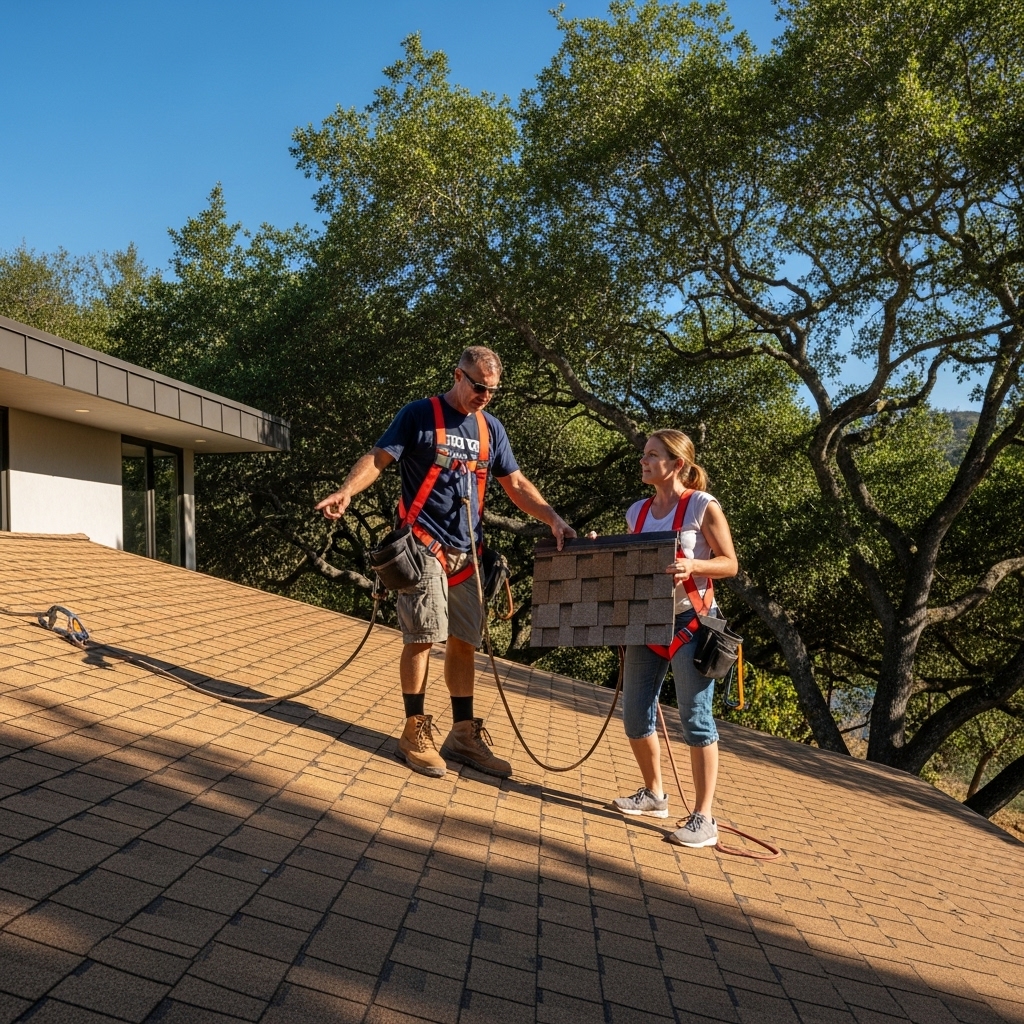Flat roofs in Oxnard live at the intersection of fog, sun, and wind. That combination can treat a well-built system kindly for years, or it can exploit little lapses in care and turn them into big problems. The difference is maintenance that respects our coastal conditions and the way local buildings are used. If you are responsible for a commercial or multifamily property, think of maintenance as a steady cadence rather than a scramble after the first heavy rain. A good plan starts with an understanding of how flat roofing behaves in Ventura County and continues with habits that keep water moving, seams tight, and details sound.
The marine layer is Oxnard’s signature. Moisture arrives as a soft blanket that can linger into midday, then burns off under bright sun. That daily cycle—cool, damp mornings followed by warm, dry afternoons—makes membranes expand and contract. Over time, the motion is small but relentless, testing seams, corners, and terminations. Maintenance that anticipates this includes periodic seam checks, close looks at inside and outside corners, and attention to parapet transitions where movement often shows first. When a technician catches a lifted edge early, a small touch-up can prevent a larger opening months later.
Drainage is the next pillar. Our storms may be brief but intense, and long stretches of mist drop organic debris that drifts into drains and scuppers. A drain that flows freely one week can slow the next. Routine checks ahead of the rainy season and after wind events keep water from lingering in low spots. Even small puddles, if they persist, can embrittle some materials and magnify minor defects. Maintenance visits typically include clearing leaves and granules, verifying strainers are secure, and confirming that drain bowls and seals are seated correctly. If low spots appear, the plan may include reinforcement or adjustments to restore positive drainage.
Salt air introduces a quiet, steady pressure on metal components. Copings, counterflashings, and fasteners along the roof edge can show surface corrosion sooner than inland counterparts. A thorough maintenance routine looks for early signs—discoloration, rust bloom, or loose hardware—and addresses them before they become movement points during wind gusts. Cleaning, treating, or replacing affected pieces when needed keeps the membrane termination strong, which is essential on breezy afternoons when uplift tries to work under the edge.
The way a roof is used matters as much as the weather. Mechanical contractors, solar technicians, and maintenance staff all move across the surface for their work. Without clear walk paths and basic access rules, damage creeps in: a dropped screwdriver punctures a membrane, a dragged panel scuffs a seam, or a heavy box compresses insulation. A maintenance plan that includes designated walkways, pads near equipment, and quick education for anyone accessing the roof prevents many of these avoidable issues. The goal is not to make access difficult; it is to guide traffic so the membrane stays safe.
Documentation turns maintenance from a reactive chore into an intelligent strategy. Photos from each visit, marked roof plans showing areas of attention, and notes about materials used create a living record. Over a handful of seasons, patterns emerge. Perhaps one parapet corner opens after wind events, or a certain drain collects debris faster than the rest. With that knowledge, maintenance can be proactive—reinforce the recurring corner and schedule an extra check on the busy drain before storms. For properties with multiple buildings, records help compare performance and share solutions across similar roofs.
In Oxnard, timing your maintenance visits pays off. A pre-rainy season inspection, a mid-season check after the first significant storm, and a spring review after winter weather form a reliable rhythm. Add a quick look after unusually strong winds or when nearby construction kicks dust and debris into the air. That cadence respects both the weather and the way our roofs age. It is not about a fixed calendar date; it is about syncing care with environmental stress.
Small repairs during maintenance make a big difference. Sealing a tiny split near a penetration, re-adhering a lifted seam edge, or tightening a loose clamp around a vent stack are quick, low-disruption tasks that protect the system. Waiting turns these corrective touches into larger repairs that take longer and affect building operations. Crews carry compatible primers and patch materials so they can address what they find without deferring simple fixes.
Skylights and penetrations deserve special attention. UV exposure and thermal movement work on seals and gaskets. On older skylights, crazing can start at corners, while newer assemblies may need periodic gasket maintenance to keep a water-tight fit. Vents and curbs should be checked for secure flashings and terminations. Inside corners, where stress concentrates, are frequent candidates for reinforcement during maintenance.
Housekeeping supports longevity. Keeping the roof free of loose debris, ensuring that pallets and packaging from other trades do not linger, and storing spare materials properly reduce incidental damage. In windy conditions, unsecured items can shift and scuff the membrane or wedge against flashings. A tidy roof is not just pleasing to look at; it is safer and more durable.
When the marine layer is heavy, moisture can mask problems, especially on smooth membranes. Early-day inspections might see a uniform damp sheen that hides hairline splits. Savvy technicians in Oxnard time detail evaluations for when the surface is dry, or they blot and inspect closely in suspect areas. That practice reduces false confidence and ensures that issues are truly resolved.
Communication is a maintenance tool. Brief reports after each visit—what was found, what was done, and what to watch—keep owners and managers aligned. If a larger issue is brewing, such as persistent ponding or aging flashings, those notes become the starting point for planning a more substantial repair or restoration. Surprises are rare when everyone stays informed.
Choosing who performs maintenance is part of the strategy. A local team familiar with Oxnard’s weather patterns and building stock brings not just technical skill but context. They know which neighborhoods see more wind, how salt air moves inland on certain days, and how to schedule around marine layer and dew points. That experience translates to better outcomes: fewer call-backs, sturdier repairs, and roofs that age gracefully.
Finally, remember that maintenance is an investment in predictability. It turns weather from an adversary into a known variable and makes your roof a managed asset rather than an emergency waiting to unfold. The return shows up in quieter rainy seasons, calmer tenants, and roofs that reach or exceed their expected service life.
How often should a flat roof be inspected in Oxnard?
A practical cadence includes a pre-rainy season inspection, a check after the first significant storm, and a spring review. Add visits after notable wind events or when other trades have been active on the roof. This rhythm aligns with our coastal climate and catches issues before they grow.
What maintenance tasks can building staff handle between professional visits?
Basic housekeeping—keeping drains clear, removing loose debris, and ensuring roof access points are secured—goes a long way. Staff should avoid using incompatible sealants or attempting membrane repairs without training. When in doubt, document and call for a professional evaluation to prevent well-intentioned damage.
Does maintenance affect warranty coverage?
Yes. Most manufacturers require documented maintenance and proper access control to keep warranties in force. Records of inspections, repairs, and any changes on the roof demonstrate care and support warranty claims if issues arise. Skipping maintenance can jeopardize coverage.
How do coastal conditions change maintenance priorities?
Salt air accelerates corrosion on metal edges and fasteners, so edge details and terminations deserve extra attention. Morning moisture compresses inspection windows and can hide fine defects, which is why timing matters. Wind management—securing loose items and reinforcing vulnerable corners—also rises in importance near the coast.
What are signs that a maintenance visit should happen sooner rather than later?
Ponding that persists after rain, recurring debris around specific drains, visible lifting at seams or corners, and interior staining after windy rain are all signals. Unusual noise or vibration from rooftop equipment can also stress flashings and merits a check.
If it has been a while since your roof had a professional look, or if you want a maintenance plan tailored to Oxnard’s coastal weather, reach out to schedule a thoughtful evaluation. A short visit today can prevent unnecessary headaches down the road. For attentive care, clear communication, and long-term reliability, connect with local specialists in flat roofing who know our climate and our buildings.






